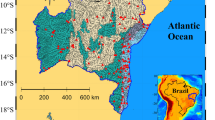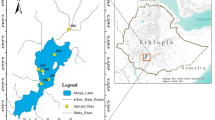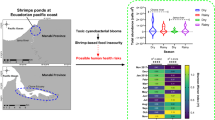Abstract
Human activities in riverine water bodies can cause loading of nutrients and other pollutants in receiving systems, affecting species interactions and population dynamics. The present study aimed to investigate the influence of anthropogenic alteration on an artificial water body, i.e., the Shahid Rajaee reservoir, in Iran that is experiencing a serious water crisis. The reservoir is subject to high anthropogenic nutrient loads from the Shirinroud and Sefidroud rivers, the effect of which needs to be evaluated considering the strategic importance of the reservoir as a source of drinking water. A field sampling campaign was carried out at seven stations (one in each of the two river mouths and five in the reservoir itself) each month from April to July 2016. The study entailed sampling of benthic macroinvertebrate fauna at the river mouths and plankton communities at the reservoir stations. In addition to macroinvertebrate and plankton, abiotic and nutrient variables were measured at all stations. Substantial loading of organic matter, mainly from the Shirinroud River, was detected throughout the sampling period, with a detrimental effect on both benthic and plankton communities. The decline in plankton diversity was particularly noticeable at stations close to the river mouths during June and July, with a bloom of Dinoflagellata and Cyanobacteria and strong dominance of larger zooplankton taxa, e.g., Copepoda. Our results suggest that river water quality, affected by human activities, alters the planktonic communities in Rajaee reservoir. Our assessment indicates that measures on both the Shirinroud River and the reservoir are required to mitigate and prevent even stronger eutrophication of the reservoir ecosystem.









Similar content being viewed by others
Data availability
The datasets generated during the current study are available in the LifeWatch ERIC at https://doi.org/10.48372/5efe843b-3e64-4a80-9978-8d9174fdd02b.
References
Aazami J, Esmaili-Sari A, Abdoli A et al (2015) Monitoring and assessment of water health quality in the Tajan River, Iran using physicochemical, fish and macroinvertebrates indices. J Environ Heal Sci Eng 13:29. https://doi.org/10.1186/s40201-015-0186-y
Akay E, Dalkıran N (2020) Assessing biological water quality of Yalakdere stream (Yalova, Turkey) with benthic macroinvertebrate-based metrics. Biologia 75:1347–1363. https://doi.org/10.2478/s11756-019-00387-9
Anufriieva E, Kolesnikova E, Revkova T, Shadrin N (2022) Spatio-temporal variability of zooplankton and zoobenthos as the elements of integrated zoocenosis in a marine lake (Crimea, Black Sea): What is a general pattern? J Sea Res 185:102231. https://doi.org/10.1016/j.seares.2022.102231
Anufriieva E, Shadrin N (2020) The long-term changes in plankton composition: Is Bay Sivash transforming back into one of the world’s largest habitats of Artemia sp. Anostraca)? Aquac Res 51:341–350. https://doi.org/10.1111/are.14381. Crustacea
APHA (2005) Standard methods for the examination of water and wastewater. APHA-AWWA-WEF, Washington, D.C.
Banerjee M, Mukherjee J, Ray S (2017) A review on reservoir system and its ecology in Indian perspective. Proc Zool Soc 70:5–20. https://doi.org/10.1007/s12595-016-0165-z
Botes L (2001) Phytoplankton identification catalogue: Saldanha Bay, April 2001. Programme Coordination Unit, Global Ballast Water Management Programme, International Maritime Organization, London
Boulaaba S, Zrelli S, Boumaiza M, Rossaro B (2014) Relationships between physical and chemical factors and aquatic macroinvertebrates in perennial streams in the arid northern mountain basin El Batinah, Oman. J Entomol Acarol Res 46:50–58
Bruno MC, Reid JW, Perry SA (2005) A list and identification key for the freshwater, free-living copepods of Florida (U.S.A.). J Crustac Biol 25:384–400. https://doi.org/10.1651/C-2538
Carlson RE (1977) A trophic state index for lakes1. Limnol Oceanogr 22:361–369. https://doi.org/10.4319/lo.1977.22.2.0361
Cebrian J, Shurin JB, Borer ET et al (2009) Producer nutritional quality controls ecosystem trophic structure. PLoS ONE 4:e4929. https://doi.org/10.1371/journal.pone.0004929
Chakraborty S, Ramesh A, Dutta PS (2016) Toxic phytoplankton as a keystone species in aquatic ecosystems: stable coexistence to biodiversity. Oikos 125:735–746
Cozzoli F, Shokri M, Boulamail S et al (2022) The size dependency of foraging behaviour: an empirical test performed on aquatic amphipods. Oecologia 199:377–386. https://doi.org/10.1007/s00442-022-05195-8
Cozzoli F, Shokri M, Gomes da Conceição T et al (2021) Modelling spatial and temporal patterns in bioturbator effects on sediment resuspension: A biophysical metabolic approach. Sci Total Environ 792:148215. https://doi.org/10.1016/j.scitotenv.2021.148215
Cozzoli F, Shokri M, Ligetta G et al (2020) Relationship between individual metabolic rate and patch departure behaviour: evidence from aquatic gastropods. Oikos 129:1657–1667. https://doi.org/10.1111/oik.07378
Davidowicz P, Maciej Gliwicz Z, Gulati RD (1988) Can Daphnia prevent a blue-green algal bloom in hypertrophic lakes?: a laboratory test. Limnologica 19:21–26
de Lucas Pardo MA, Bakker M, van Kessel T et al (2013) Erodibility of soft freshwater sediments in Markermeer: the role of bioturbation by meiobenthic fauna. Ocean Dyn 63:1137–1150. https://doi.org/10.1007/s10236-013-0650-0
De Vries A, Ripley BD (2016) ggdendro: create dendrograms and tree diagrams using “ggplot2”. CRAN
Defaye D (1988) Contribution à la connaissance des Crustacés Copépodes d’Ethiopie. Hydrobiologia 164:103–147. https://doi.org/10.1007/BF00008454
Ebraheim G, Zonoozi MH, Saeedi M (2020) A comparative study on the performance of NSFWQIm and IRWQIsc in water quality assessment of Sefidroud River in northern Iran. Environ Monit Assess 192:677. https://doi.org/10.1007/s10661-020-08630-6
Elliott JM, Humpesch UH, Macan TT (1988) Larvae of the British Ephemeroptera: a key with ecological notes. Freshwater Biological Association, Ambleside, Cumbria
Ertaş A, Yorulmaz B, Sukatar A (2022) Comparative analysis of biotic indices for assessment of water quality of Balaban Stream in West Anatolia. Turk Biol. https://doi.org/10.1007/s11756-021-00992-7
García-Chicote J, Armengol X, Rojo C (2018) Zooplankton abundance: A neglected key element in the evaluation of reservoir water quality. Limnologica 69:46–54. https://doi.org/10.1016/j.limno.2017.11.004
Ghanbarpour MR, Zolfaghari S, Geiss C, Darvari Z (2013) Investigation of river flow alterations using environmental flow assessment and hydrologic indices: Tajan River Watershed, Iran. Int J River Basin Manag 11:311–321. https://doi.org/10.1080/15715124.2013.823978
Gołdyn R, Kowalczewska-Madura K (2007) Interactions between phytoplankton and zooplankton in the hypertrophic Swarzędzkie Lake in western Poland. J Plankton Res 30:33–42. https://doi.org/10.1093/plankt/fbm086
Gordon ND, McMahon TA, Finlayson BL et al (2004) Stream hydrology: an introduction for ecologists. John Wiley and Sons, Chichester, West Sussex, England
Hatton IA, McCann KS, Fryxell JM et al (2015) The predator-prey power law: Biomass scaling across terrestrial and aquatic biomes. Science 349:aac6284. https://doi.org/10.1126/science.aac6284
Hering D, Carvalho L, Argillier C et al (2015) Managing aquatic ecosystems and water resources under multiple stress — An introduction to the MARS project. Sci Total Environ 503–504:10–21. https://doi.org/10.1016/j.scitotenv.2014.06.106
Hering D, Meier C, Rawer-Jost C et al (2004) Assessing streams in Germany with benthic invertebrates: selection of candidate metrics. Limnologica 34:398–415. https://doi.org/10.1016/S0075-9511(04)80009-4
Hijmans RJ, Van Etten J et al (2015) Package raster: geographic data analysis and modeling. CRAN
Hilsenhoff WL (1988) Rapid field assessment of organic pollution with a family-level biotic index. J North Am Benthol Soc 7:65–68. https://doi.org/10.2307/1467832
Hunt RJ, Matveev VF (2005) The effects of nutrients and zooplankton community structure on phytoplankton growth in a subtropical Australian reservoir: An enclosure study. Limnologica 35:90–101. https://doi.org/10.1016/j.limno.2005.01.004
Jeppesen E, Peder Jensen J, SØndergaard M et al (2000) Trophic structure, species richness and biodiversity in Danish lakes: changes along a phosphorus gradient. Freshw Biol 45:201–218. https://doi.org/10.1046/j.1365-2427.2000.00675.x
Kehayias G, Chalkia E, Chalkia S et al (2008) Zooplankton dynamics in the upstream part of Stratos reservoir (Greece). Biologia 63:699–710. https://doi.org/10.2478/s11756-008-0129-5
Kivrak E (2006) Seasonal and long term changes of the phytoplankton in the lake Tortum in relation to environmental factors. Erzurum Turk Biol 61:339–345. https://doi.org/10.2478/s11756-006-0062-4
Klamt A-M, Hilt S, Moros M et al (2019) The effect of a shift from macrophyte to phytoplankton dominance on phosphorus forms and burial in the sediments of a shallow hard-water lake. Biogeochemistry 143:371–385. https://doi.org/10.1007/s10533-019-00567-4
Kozak A, Gołdyn R, Dondajewska R (2015) Phytoplankton composition and abundance in restored maltański reservoir under the influence of physico-chemical variables and zooplankton grazing pressure. PLoS ONE 10:e0124738. https://doi.org/10.1371/journal.pone.0124738
Lampert W (1988) The relationship between zooplankton biomass and grazing: a review. Limologica 19:11–20
Lenat DR (1993) A biotic index for the southeastern United States: derivation and list of tolerance values, with criteria for assigning water-quality ratings. J North Am Benthol Soc 12:279–290. https://doi.org/10.2307/1467463
Litchman E, de Tezanos Pinto P, Klausmeier CA et al (2010) Linking traits to species diversity and community structure in phytoplankton. Hydrobiologia 653:15–28. https://doi.org/10.1007/s10750-010-0341-5
Makhlough A, Saravi HN, Ebrahimzadeh M (2017) The water quality of the Shahid Rajaee reservoir (Mazandaran-Iran): based on phytoplankton community. Iran J Sci Technol Trans Sci 41:627–635. https://doi.org/10.1007/s40995-017-0299-5
Malvandi H, Moghanizade R, Abdoli A (2021) The use of biological indices and diversity indices to evaluate water quality of rivers in Mashhad. Iran Biol 76:959–971. https://doi.org/10.2478/s11756-020-00618-4
Matsuura P, Perbiche-Neves G, Ferreira RAR, Nogueira MG (2015) Changes in the phytoplankton structure downstream a large reservoir: effects of tributaries on the assemblages attributes. Biologia 70:320–327. https://doi.org/10.1515/biolog-2015-0037
Milligan MR (1997) Identification manual for the aquatic Oligochaeta of Florida: Freshwater Oligochaetes. State of Florida, Department of Environmental Protection, Division of Water Facilities, Florida, USA
Mirzavand M, Bagheri R (2020) The water crisis in Iran: Development or destruction? World Water Policy 6:89–97. https://doi.org/10.1002/wwp2.12023
Moestrup Ø (1988) Atlas du Phytoplancton Marin, Vol. 1: Cyanophyées, Dictyohcophycées, Dinophycées, Raphidophycées. Phycologia 27:301–302. https://doi.org/10.2216/i0031-8884-27-2-301.1
Nakano T, Tayasu I, Yamada Y et al (2008) Effect of agriculture on water quality of Lake Biwa tributaries, Japan. Sci Total Environ 389:132–148. https://doi.org/10.1016/j.scitotenv.2007.08.042
Ntitslidou C, Rossaro B, Lazaridou M, Bobori DC (2021) What drives benthic macroinvertebrate dispersal in different lake substrata? The case of three Mediterranean lakes. Aquat Ecol 55:1033–1050. https://doi.org/10.1007/s10452-021-09880-3
Obolewski K, Glińska-Lewczuk K, Strzelczak A (2014) The use of benthic macroinvertebrate metrics in the assessment of ecological status of floodplain lakes. J Freshw Ecol 29:225–242. https://doi.org/10.1080/02705060.2013.876943
Oksanen J, Blanchet FG, Friendly M et al (2019) vegan: Community ecology package. Compr R Arch Netw
Pescador ML, Rasmussen AK, Harris SC (2004) Identification manual for the caddisfly (Trichoptera) larvae of Florida. Division of Water Resource Management, Florida Department of Environmental Protection
Prescott GW (1954) How to know the fresh-water algae; an illustrated key for identifying the more common fresh-water algae to genus, with hundreds of species named pictured and with numerous aids for their study. W.C. Brown Co., Dubuque, Iowa
R Core Team (2019) R: A language and environment for statistical computing. R Foundation for statistical computing, Vienna, Austria. Available at: https://www.R-project.org/
Rossaro B, Cortesi P (2013) The effects of tricyclazole treatment on aquatic macroinvertebrates in the field and in laboratory. J Entomol Acarol Res 45:128–136. https://doi.org/10.4081/jear.2013.e23
Rossaro B, Marziali L, Cardoso AC et al (2007) A biotic index using benthic macroinvertebrates for Italian lakes. Ecol Indic 7:412–429. https://doi.org/10.1016/j.ecolind.2006.04.002
Ryabov A, Kerimoglu O, Litchman E et al (2021) Shape matters: the relationship between cell geometry and diversity in phytoplankton. Ecol Lett 24:847–861. https://doi.org/10.1111/ele.13680
Selmeczy GB, Abonyi A, Krienitz L et al (2019) Old sins have long shadows: climate change weakens efficiency of trophic coupling of phyto- and zooplankton in a deep oligo-mesotrophic lowland lake (Stechlin, Germany)—a causality analysis. Hydrobiologia 831:101–117. https://doi.org/10.1007/s10750-018-3793-7
Selmeczy GB, Krienitz L, Casper P, Padisák J (2018) Phytoplankton response to experimental thermocline deepening: a mesocosm experiment. Hydrobiologia 805:259–271. https://doi.org/10.1007/s10750-017-3308-y
Shakeri A, Shakeri R, Mehrabi B (2015) Potentially toxic elements and persistent organic pollutants in water and fish at Shahid Rajaei Dam, north of Iran. Int J Environ Sci Technol 12:2201–2212. https://doi.org/10.1007/s13762-015-0754-9
Shokri M, Ciotti M, Vignes F et al (2019) Components of standard metabolic rate variability in three species of gammarids. Web Ecol 19:1–13. https://doi.org/10.5194/we-19-1-2019
Shokri M, Cozzoli F, Ciotti M et al (2021) A new approach to assessing the space use behavior of macroinvertebrates by automated video tracking. Ecol Evol 11:3004–3014. https://doi.org/10.1002/ece3.7129
Shokri M, Rossaro B, Rahmani H (2014) Response of macroinvertebrate communities to anthropogenic pressures in Tajan River (Iran). https://doi.org/10.2478/s11756-014-0448-7. Biologia
Singh RK (1983) The role of the littoral (shallow) zone in reservoir productivity. Acta Hydrochim Hydrobiol 11:101–107. https://doi.org/10.1002/aheh.19830110112
Sommer U, Sommer F, Santer B et al (2003) Daphnia versus copepod impact on summer phytoplankton: functional compensation at both trophic levels. Oecologia 135:639–647. https://doi.org/10.1007/s00442-003-1214-7
Tabesh M, kazemnejad Sangroudi G (2017) Environmental assessment of urban water and wastewater systems from greenhouse gasses production point of view; case study: city of Sari. J Environ Stud 43:117–134. https://doi.org/10.22059/jes.2017.62065
Talling JF, Driver D (1963) Some problems in the estimation of chlorophyll-a in phytoplankton. In: Proceedings of the Conference of Primary Productivity Measurement, Marine and Freshwater, University of Hawaii, Honolulu, Atomic Energy Commission TID-7633, pp 142-146
Tang J, Cao H (2019) Structural adaptions of phytoplankton assemblages along two contrasting reservoirs. Biologia 74:139–148. https://doi.org/10.2478/s11756-018-0160-0
Tapolczai K, Selmeczy GB, Szabó B et al (2021) The potential of exact sequence variants (ESVs) to interpret and assess the impact of agricultural pressure on stream diatom assemblages revealed by DNA metabarcoding. Ecol Indic 122:107322. https://doi.org/10.1016/j.ecolind.2020.107322
Tarinejad R, Ahmadi MT, Harichandran RS (2014) Full-scale experimental modal analysis of an arch dam: The first experience in Iran. Soil Dyn Earthq Eng 61–62:188–196. https://doi.org/10.1016/j.soildyn.2014.01.020
Toklu-Alicli B, Balkis-Ozdelice N, Durmus T, Balci M (2021) Relationship between environmental factors and zooplankton diversity in the Gulf of Bandırma (the Sea of Marmara). Biologia 76:1727–1736. https://doi.org/10.2478/s11756-020-00668-8
Utermöhl H (1958) Zur vervollkommnung der quantitativen phytoplankton-methodik: Mit 1 Tabelle und 15 abbildungen im Text und auf 1 Tafel. Int Ver für Theor und Angew Limnol Mitteilungen 9:1–38
Voigt M, Koste W, Koste W (1987) Rotatoria: Die Rädertiere Mitteleuropas Überordnung Monogononta, 2nd edn. Wissenschaftsverlage Schweizerbart und Gebr. Borntraeger, Stuttgart, Germany
von Dassow P, Montresor M (2010) Unveiling the mysteries of phytoplankton life cycles: patterns and opportunities behind complexity. J Plankton Res 33:3–12. https://doi.org/10.1093/plankt/fbq137
Vuglinskiy V(2009) Water level; Assessment of the status of the development of the standards for the Terrestrial Essential Climate Variables. Rome, Italy
Wehr JD (2011) Freshwater algae: Identification and use as bioindicators. J Phycol 47:436–438. https://doi.org/10.1111/j.1529-8817.2011.00973.x
Wei T, Simko V (2017) R package “corrplot”. Visualization of a Correlation Matrix. CRAN
Wetzel RG, Likens GE (2000) Limnological Analyses. Springer Science & Business Media, New York, USA
Wickham H (2016) ggplot2: Elegant Graphics for Data Analysis. Springer-Verlag, New York
Acknowledgements
Our thanks to the laboratory of the Mazandaran Regional water company for their support in analysing water samples. We thank George Metcalf for language editing and Prof. Bahram Kiabi for his comments on an earlier version of the manuscript.
Funding
This publication resulted in part from a project funded by the Department of the Environment of the Islamic Republic of Iran, Mazandaran, under award number 29544. The funder had no role in study design, data collection and analysis, decision to publish or preparation of the manuscript.
Author information
Authors and Affiliations
Contributions
HR conceived and supervised the project. HR, KJ, AA carried out the field study. MS analysed the data and wrote the first draft of the paper. All the authors contributed, reviewed, and approved the final version of the manuscript.
Corresponding author
Ethics declarations
Conflict of interest
The authors declare that they have no conflict of interest.
Additional information
Publisher’s note
Springer Nature remains neutral with regard to jurisdictional claims in published maps and institutional affiliations.
Electronic supplementary material
Below is the link to the electronic supplementary material.
Rights and permissions
Springer Nature or its licensor holds exclusive rights to this article under a publishing agreement with the author(s) or other rightsholder(s); author self-archiving of the accepted manuscript version of this article is solely governed by the terms of such publishing agreement and applicable law.
About this article
Cite this article
Rahmani, H., Shokri, M., Janikhalili, K. et al. Relationships among biotic, abiotic parameters and ecological status in Shahid Rajaee reservoir (Iran). Biologia 77, 3159–3172 (2022). https://doi.org/10.1007/s11756-022-01203-7
Received:
Accepted:
Published:
Issue Date:
DOI: https://doi.org/10.1007/s11756-022-01203-7




